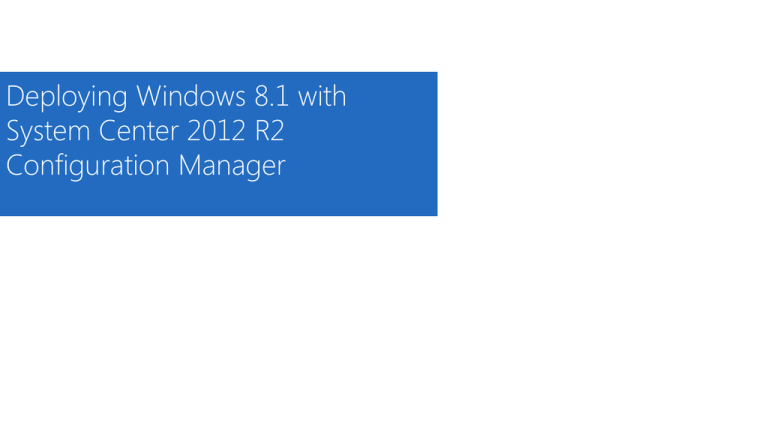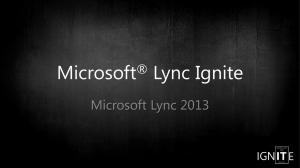
Deploying Windows 8.1 with
System Center 2012 R2
Configuration Manager
Conditions and Terms of Use
Microsoft Confidential
This training package is proprietary and confidential, and is intended only for uses described in the training materials. Content and software is provided to you
under a Non-Disclosure Agreement and cannot be distributed. Copying or disclosing all or any portion of the content and/or software included in such packages is
strictly prohibited.
The contents of this package are for informational and training purposes only and are provided "as is" without warranty of any kind, whether express or implied,
including but not limited to the implied warranties of merchantability, fitness for a particular purpose, and non-infringement.
Training package content, including URLs and other Internet website references, is subject to change without notice. Because Microsoft must respond to changing
market conditions, the content should not be interpreted to be a commitment on the part of Microsoft, and Microsoft cannot guarantee the accuracy of any
information presented after the date of publication. Unless otherwise noted, the companies, organizations, products, domain names, e-mail addresses, logos,
people, places, and events depicted herein are fictitious, and no association with any real company, organization, product, domain name, e-mail address, logo,
person, place, or event is intended or should be inferred.
Copyright and Trademarks
© 2014 Microsoft Corporation. All rights reserved.
Microsoft may have patents, patent applications, trademarks, copyrights, or other intellectual property rights covering subject matter in this document. Except as
expressly provided in written license agreement from Microsoft, the furnishing of this document does not give you any license to these patents, trademarks,
copyrights, or other intellectual property.
Complying with all applicable copyright laws is the responsibility of the user. Without limiting the rights under copyright, no part of this document may be
reproduced, stored in or introduced into a retrieval system, or transmitted in any form or by any means (electronic, mechanical, photocopying, recording, or
otherwise), or for any purpose, without the express written permission of Microsoft Corporation.
For more information, see Use of Microsoft Copyrighted Content at
http://www.microsoft.com/about/legal/permissions/
Microsoft®, Internet Explorer®, Outlook®, OneDrive®, Windows Vista®, Zune®, Xbox 360®, DirectX®, Windows Server® and Windows® are either registered
trademarks or trademarks of Microsoft Corporation in the United States and/or other countries. Other Microsoft products mentioned herein may be either
registered trademarks or trademarks of Microsoft Corporation in the United States and/or other countries. All other trademarks are property of their respective
owners.
Module 1: The New
Hardware:
BIOS, UEFI, and You
Module Overview:
• What is UEFI
• New challenges faced with imaging
systems with UEFI
Microsoft Confidential
3
Brief History of BIOS
The Basic Input/Output System (BIOS)
What does the BIOS do?
BIOS is now considered legacy BIOS
Microsoft
Partner Network
Reasons to Replace the BIOS
2.2 TB
drive limit
Limited option
ROM space
16-bit Real
Mode
Lack of
networking
support (IPv6)
Aging GUI
OEM x64
standardization
Microsoft
Partner Network
BIOS Partitions
Single Windows Partition
Recommended BIOS configuration
Microsoft
Partner Network
BIOS Partitions
Single Windows Partition
Recommended BIOS configuration
Microsoft
Partner Network
Configuring UEFI Partitions
Default configuration
Recommended configuration
Microsoft
Partner Network
Configuring UEFI Partitions
Microsoft
Partner Network
Support for PXE Booting UEFI ONLY System
•
•
•
System Center 2012 SP1 Configuration Manager introduced support for UEFI
systems.
x86/IA32 UEFI Only systems require WDS on Windows Server 2012 (i.e. Intel
ATOM based tablets) (http://support.microsoft.com/kb/2845997)
x86/IA32 UEFI Only systems require System Center 2012 R2 Configuration
Manager (http://technet.microsoft.com/en-us/library/dn236351.aspx)
Microsoft Confidential
Module 2: Deploying
Windows 8.1
Module Overview
Microsoft Confidential
11
Deploying Windows
8.1
Similar to Windows 7 Deployment
• Deployment Image Servicing and
Management (DISM)
• Windows System Image Manager (WSIM)
• Unattended.xml
• USMT
Microsoft Confidential
New Challenges
• UEFI
• Tablets
• Appx Packages
• Start Screen Customization
• Disabling access to the store
• Lock Screen and Desktop images
• LocalGPO tool
12
Appx Packages
•
•
Mount WIM to a temp directory
Dism /Image:C:\test\offline /Get-ProvisionedAppxPackages
•
Dism /Image:C:\test\offline /Remove-ProvisionedAppxPackage
/PackageName:
•
•
•
•
•
•
•
•
•
•
•
•
•
•
Microsoft.BingFinance_2013.809.632.3676_neutral_~_8wekyb3d8bbwe
Microsoft.BingFoodAndDrink_2013.820.258.2561_neutral_~_8wekyb3d8bbwe
Microsoft.BingHealthAndFitness_2013.813.243.3760_neutral_~_8wekyb3d8bbwe
Microsoft.BingMaps_2013.809.2206.5385_neutral_~_8wekyb3d8bbwe
Microsoft.BingNews_2013.809.636.2800_neutral_~_8wekyb3d8bbwe
Microsoft.BingSports_2013.809.637.2803_neutral_~_8wekyb3d8bbwe
Microsoft.BingTravel_2013.809.639.25_neutral_~_8wekyb3d8bbwe
Microsoft.BingWeather_2013.809.641.3233_neutral_~_8wekyb3d8bbwe
Microsoft.SkypeApp_2013.805.1159.2246_neutral_~_kzf8qxf38zg5c
Microsoft.WindowsReadingList_2013.822.1837.5741_neutral_~_8wekyb3d8bbwe
Microsoft.XboxLIVEGames_2013.808.1749.4769_neutral_~_8wekyb3d8bbwe
Microsoft.ZuneMusic_2013.809.1658.2765_neutral_~_8wekyb3d8bbwe
Microsoft.ZuneVideo_2013.809.1659.3015_neutral_~_8wekyb3d8bbwe
Microsoft.windowscommunicationsapps_2013.822.1740.2836_neutral_~_8wekyb3d8bbwe
http://technet.microsoft.com/en-us/library/hh824882.aspx
Microsoft Confidential
13
Start Screen
Customizations
Log into the reference system and make your start screen customizations
Manual Method
•
CopyProfile = True in Unattended.xml
•
StartTiles setting in Unattended.xml - Note: (CopyProfile wins)
•
Copy the AppsFolderLayout.bin (obtain from Sysprep Audit Mode)
http://technet.microsoft.com/en-us/library/jj134269.aspx#BKMK_AppFolder
Using Powershell and GPO
•
Export-StartLayout
•
User Configuration\Administrative Templates\Start Menu and
Taskbar\Start Screen Layout
http://technet.microsoft.com/en-us/library/dn467928.aspx
Microsoft Confidential
14
Sample Script
Microsoft Confidential
15
Disable Store Access
GPO - Computer Configuration\Administrative Templates\Windows
Components\Store
•
Turn off the Store Application
•
Turn off Automatic Download and Install of updates
•
Turn off Automatic Download of updates on Win8 machines
•
Turn off the offer to update to the latest version of Windows
http://support.microsoft.com/kb/2826659/en-us
http://technet.microsoft.com/en-us/library/hh832040.aspx
Microsoft Confidential
16
Set Lock Screen and
Background
Lock Screen Custom Image
GPO - Computer Configuration\Policies\Administrative Templates\Control
Panel\Personalization\Force a specific default lock screen image
•
Set path to the customized Lock Screen Image
•
Windows must be Activated!
http://support.microsoft.com/kb/2787100/EN-US
Background Wallpaper Customization
GPO - User Configuration\Policies\Administrative Templates\Desktop\Desktop\Desktop
Wallpaper
•
Set path to the customized wallpaper image
Microsoft Confidential
17
Using the LocalGPO
Tool
Security Compliance Manager 3.0
•
Install SCM on Admin Workstation
•
Install Local GPO on a Test/Reference System
C:\Program Files\Microsoft Security Compliance Manager\LGPO\LocalGPO.msi
•
Set desired GPO on a Test/Reference System (gpedit.msc to edit local policy)
•
Use LocalGPO to backup the settings
cscript LocalGPO.wsf /Path:c:\Images\Win8.1Build /Export
•
Use LocalGPO to create a GPOPack
cscript LocalGPO.wsf /path:C:\images\Win8.1Build /export /gpopack
•
Make the folder name “friendly” (rename {8C7CF2F2-1541-4D19-AE7F-EEA4F9510868} to
Win8.1_GPOPACK)
•
Apply GPOPack during Task Sequence
cscript GPOPack.wsf /silent
Note:
For Windows 8.1, LocalGPO.wsf and GPOPack.wsf need to be modified to support Windows 8.1 (version 6.3)
Microsoft Confidential
18
Sub ChkOSVersion
Fixing LocalGPO.wsf
and GPOPack.wsf
for Windows 8.1 (At
Your Own Risk)
Microsoft Confidential
19
Module 3: Upgrading from
Windows 8 to Windows 8.1
Module Overview
• The upgrade process
• Preparation for the upgrade
• Upgrading machines via SCCM 2012
Microsoft Confidential
20
Upgrade Process
•
The windows upgrade process can upgrade a Windows 8 machine to Windows 8.1
in place
•
The upgrade can carry over data from the previous OS as well as applications
•
This upgrade can be run manually on a single machine or can be run through SCCM
across an entire enterprise
•
NOTE: The automated upgrade process can ONLY be run on Windows Enterprise
machines with volume licenses
Microsoft Confidential
21
•
Windows 8.1 Upgrade Assistant
Preparation for the
upgrade
Upgrade Assistant FAQ
http://windows.microsoft.com/en-us/windows-8/upgrade-assistant-download-onlinefaq
Microsoft Confidential
22
Upgrading via
SCCM 2012
Options for upgrade deployment
1. /auto:upgrade – Upgrades and preserves Applications and Data
2. /auto:data – Upgrades and preserves only Data
3. /performdu – Performs Dynamic Updates during the upgrade
4. /noautoexit – Causes the installer to always exit verbosly
Sample Command Line for SCCM 2012
Setup.exe /auto:upgrade /performdu
Windows Installer Reference
http://technet.microsoft.com/en-us/library/hh824834.aspx
Microsoft Confidential
23
Module 4: Applying
Windows 8.1 Update 1
Module Overview
•
Prerequisites for Windows 8.1 Update 1
•
Preparations to deploy update in SCCM 2012
•
Deploying the Update via SCCM
•
Applying the Update to an existing SCCM OSD image
Microsoft Confidential
24
•
http://support.microsoft.com/kb/2919442/en-us - Prerequisite for Update
•
http://support.microsoft.com/kb/2939087/en-us - Fix for crashing issues
Prerequisites for
Windows 8.1
Update 1
Microsoft Confidential
25
•
Software Update point installed
•
Security and Critical Update Classifications syncing
Preparations to
deploy update in
SCCM 2012
Microsoft Confidential
26
Applying the
Update to an
existing SCCM OSD
image
"C:\Program Files (x86)\Windows Kits\8.1\Assessment and Deployment Kit\Deployment
Tools\amd64\DISM\dism.exe" /mount-wim /wimfile:install.wim /index:1 /mountdir:e:\images
"C:\Program Files (x86)\Windows Kits\8.1\Assessment and Deployment Kit\Deployment
Tools\amd64\DISM\dism.exe" /image:e:\images /add-package /packagepath:e:\demo\Windows8.1KB2939087-x64.msu
"C:\Program Files (x86)\Windows Kits\8.1\Assessment and Deployment Kit\Deployment
Tools\amd64\DISM\dism.exe" /image:e:\images /add-package /packagepath:e:\demo\Windows8.1KB2919355-x64.msu
"C:\Program Files (x86)\Windows Kits\8.1\Assessment and Deployment Kit\Deployment
Tools\amd64\DISM\dism.exe" /unmount-wim /mountdir:c:\images\mount /commit
Note: you must use the DISM version that is installed with the ADK that is at least as new as the OS
version you are manipulating
DISM Reference
http://technet.microsoft.com/en-us/library/hh824821.aspx
Microsoft Confidential
27
Microsoft Confidential
28







